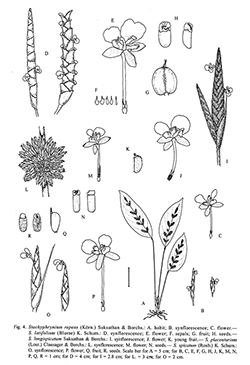e-Flora of Thailand
Volume 9 > Part 2 > Year 2008 > Page 140 > Marantaceae > Stachyphrynium
4. Stachyphrynium spicatum (Roxb.) K.Schum.wfo-0000557847
in Engl., Pflanzenr. IV, 50. 1902.— Phrynium spicatum Roxb., Hort. Bengal. 1. 1814; Fl. Ind. 1: 5. 1820. Fig. 4: O–S.
Accepted Name : This is currently accepted.
Synonyms & Citations :
Description : Rhizomatous ground herb, 64–150 cm high. Leaves 1–3 per shoot; sheath 15–40 cm long, green, glabrous; petiole (5–)21–82 cm long, green, glabrous; pulvinus 0.4–3.5 cm long, greenish or whitish-green, glabrous; lamina narrowly oblong to ovate-oblong, rarely ovate, acute to acuminate, 9.6–46.0 by 2.0–15.3 cm, dark green to light green above, pale below, glabrous. Inflorescence interfoliar, erect, often appearing to protrude from the sheath of an accompanying leaf, simple or with 2–3(–5) shorter first order branches; peduncle 1–35 cm long; main inflorescence axis ca 4–10.7 cm long; fertile bracts 6–9, distichous to subspirally arranged, ovate to narrowly lanceolate, 1.2–3.5 by 0.4–2.2 cm, acute, apiculate, light green; flower-pairs 2–3 per special paraclade, associated prophylls 6.8–19.0 by 3.5–10.0 mm, interphylls small, 2–4 by 0.5–2.3 mm. Flowers white, 3.5–4.5 cm long; sepals 3, free, linear, ca 3–3.2 by 0.6–0.7 mm, white to creamy white, with scattered reddish-brown spots; corolla tube ca 2.1–3.0 cm long; petal lobes elliptic-oblong to oblong, acute, ca 8.2–8.7 by 2.6–3.5 mm, white to pinkish- white, translucent, deflexed and curled; staminodal tube slightly longer than the corolla tube; outer staminodes 2, subequal, their petaloid lobes elliptic to obovate or broadly obovate, rounded at apex, 10.0–12.5 by 4.6–11.3 mm, white; cucullate staminode with free part of 4–5 by 1.4–1.7 mm, bright yellow or white with yellow tip, appendage small, ca 0.8 mm; callose staminode subrhombic, with free part of 3.8–4.2 by 2.7–3.7 mm, yellowish-brown; fertile stamen 1.0–1.3 mm long, with a hood-like appendage ± same size as that of the cucullate staminode; style with free part of 4–7 cm, curved; ovary ca 2.5 mm long, glabrous or with minute hairs in the upper part. Fruits broadly ellipsoid to narrowly obovate, 12–14 by 7–8 mm. Seed 1, broadly ellipsoid, ca 7 by 3.8 mm, rugose; aril large, with 2 long appendages of ca 8 mm.
Thailand : NORTHERN: Chiang Rai, Chiang Mai, Nan, Phrae, Phayao, Lampang, Tak, Phitsanulok, Sukhothai, Kamphaeng Phet; NORTH-EASTERN: Loei; EASTERN: Chaiyaphum, Nakhon Ratchasima; SOUTH-WESTERN: Uthai Thani, Kanchanaburi; SOUTH-EASTERN: Prachin Buri (Khao Yai – type of Stachyphrynium tetranthum K.Larsen: Larsen 10322, holotype -AAU, isotypes -BKF C), Chachoengsao, Chanthaburi.
Distribution : Sri Lanka, S India, Burma (type), S China, Indochina.
Ecology : Commonly found next to streams, by road sides, disturbed areas, bamboo forests and lowland evergreen forests, 150–1,000 m alt.
Vernacular : Ton kao tom (ต้นข้าวต้ม)(Sukhothai); tong-kao-tom (ตองข้าวต้ม), tong-khaem (ตองแข้ม), tong-ching (ตองจิง), tong-hueak (ตองเหือก), tong-ching-kan (ตองจิงก้าน), la-cha (ล่าจา)(Karen-Northern).
Notes: Stachyphrynium spicatum shows a great variation in plant size, inflorescence form and leaf shape. There are, however, no sharp boundaries in the variation and no consistent division into separate taxa can be established.

